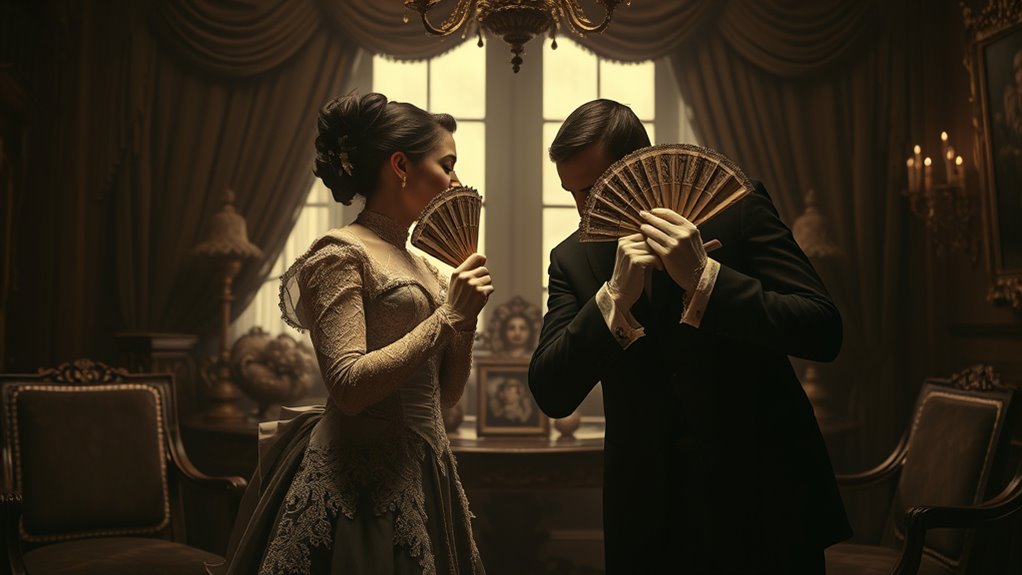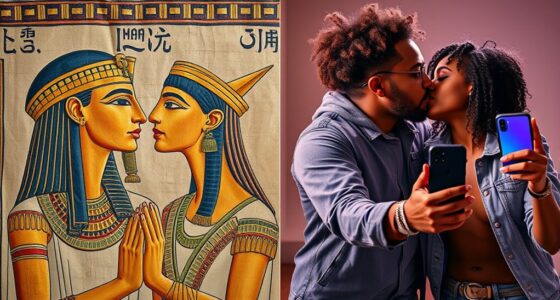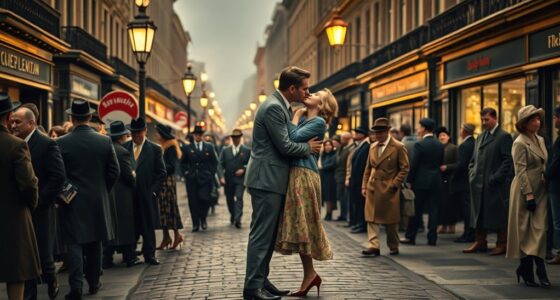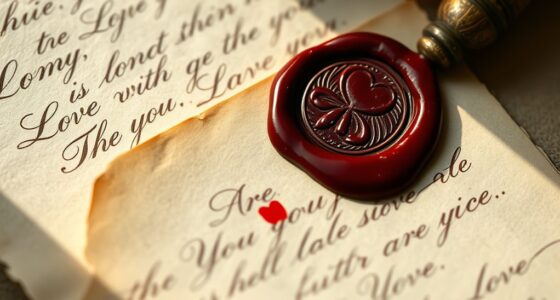Victorian society had strict rules for kissing, turning simple acts into elaborate customs that reflected social class and moral values. You might be surprised to learn that quick pecks on the cheek or hand conveyed respect, while lip kisses were reserved for private moments. Some rituals involved exchanging tokens or discreet gestures to express affection while maintaining decorum. If you keep exploring, you’ll discover how these customs secretly shaped Victorian notions of love and social standing.
Key Takeaways
- Public kisses were often considered scandalous, reserved strictly for private settings to uphold social decorum.
- Kissing on the hand or cheek served as respectful gestures, signaling admiration without breaching social norms.
- Romantic couples used symbolic acts like exchanging notes or tokens instead of public displays of affection.
- More intimate kisses on the lips were rare, reserved for private moments to maintain moral virtue.
- Kissing customs were ritualized, with specific gestures indicating social status, respect, and discretion in courtship.

During the Victorian era, kissing customs were more than just expressions of affection; they were carefully governed rituals that reflected social status and moral values. You had to navigate a complex web of romantic etiquette and social norms that dictated when, where, and how you could show physical affection. Public displays of kissing, for instance, were often frowned upon or outright forbidden, especially among the middle and upper classes. Instead, couples resorted to subtle signals and discreet gestures to communicate their feelings without risking social disapproval. Even a simple peck on the cheek could carry layers of meaning, depending on the context and the social standing of those involved.
Victorian kissing customs reflected social status and moral values, emphasizing discretion and subtlety in public displays of affection.
In this period, the rules around kissing weren’t just about personal preference—they were embedded in the fabric of societal expectations. For example, men and women were expected to adhere to strict codes of conduct, which meant that any romantic act had to be carefully timed and executed. Kissing someone in public could be seen as unseemly or scandalous, so many couples developed private or semi-private rituals to share their affection. These customs often involved symbolic gestures like touching hands, exchanging notes, or exchanging small tokens—acts that adhered to the prevailing social norms and romantic etiquette of the time. Such behaviors allowed lovers to maintain a sense of propriety while still expressing their feelings.
You’d also find that the type of kiss mattered greatly, as it carried different social signals. A quick, chaste kiss on the hand or cheek was a socially accepted form of greeting or farewell, often used to demonstrate respect or admiration. More intimate kisses, like those on the lips, were reserved for private moments and typically required a significant level of trust and social approval. For young lovers, courting rituals often involved a series of increasingly personal gestures, each carefully calibrated to fit the expectations of their social class. These customs reinforced the importance of moral virtue and social standing, shaping how couples navigated their romantic relationships.
Understanding these forgotten Victorian kissing customs reveals how deeply social norms influenced even the most personal acts of affection. You might be surprised to learn that what seems like a simple gesture today was once a carefully choreographed act, laden with social significance. These customs served to uphold societal order, ensuring that love and intimacy remained within accepted boundaries. In essence, Victorian society’s approach to kissing was about maintaining dignity and decorum, turning what we now see as spontaneous acts into a series of deliberate, rule-bound rituals. Additionally, the use of romantic signals played a crucial role in expressing affection discreetly, often preventing social scandal and safeguarding personal reputation.
Frequently Asked Questions
Were Victorian Kissing Customs Different for Men and Women?
Victorian kissing customs did differ for men and women, reflecting their roles in courtship rituals. Men often initiated romantic symbolism through discreet gestures, while women’s responses signified their feelings. These customs shaped how couples expressed affection, emphasizing social decorum. You’d notice that these rituals reinforced gender expectations, making each kiss a meaningful part of the courtship process, preserving tradition and propriety during that era.
How Did Social Class Influence Victorian Kissing Practices?
Did you know that social class distinctions heavily influenced Victorian kissing practices? Upper-class individuals often maintained strict romantic exclusivity, limiting physical contact outside formal courtship, while lower classes were more relaxed and affectionate. You’d find that social status dictated not just who you could kiss, but also how and when, reflecting broader societal divisions. These customs reinforced class boundaries, shaping intimate interactions in ways that might surprise you today.
Did Victorian Etiquette Restrict Public Displays of Affection?
Victorian etiquette definitely restricted public displays of affection, emphasizing modesty and decorum. You’d notice that romantic symbolism and courtship rituals stayed private, avoiding overt gestures that might shock society. Kissing was reserved for intimate moments, often within the confines of courtship rituals. Public affection was seen as inappropriate, so couples kept their love discreet, focusing on subtle signals rather than open displays of romance.
Were There Specific Rituals Associated With Victorian Kissing?
You might find it surprising, but Victorian courtship rituals often included specific kissing customs rooted in romantic symbolism. These rituals emphasized modesty and propriety, like secretive pecks or symbolic gestures rather than open displays. Kissing was seen as a meaningful act within courtship, often reserved for significant moments. These customs reflected Victorian values, making each kiss a carefully choreographed step in expressing affection and commitment.
How Did Victorian Kissing Customs Vary Across Regions?
You’ll find that Victorian kissing customs varied across regions, influenced by local Victorian courtship traditions and fashion. In some areas, modesty dictated discreet, quick pecks, while others embraced more elaborate gestures. Victorian fashion also played a role, with gloves or fans used to conceal or enhance romantic signals. These regional differences reflected diverse societal norms, making Victorian romance a complex and fascinating aspect of history.
Conclusion
You might think these customs are just quirky history, but they reveal how different social norms once shaped intimacy. Maybe you’re surprised by their formality or the strict rules, but understanding these traditions helps us appreciate how much attitudes toward kissing have evolved. Even if it seems strange now, it’s fascinating to see how love and politeness once intertwined so closely. History’s quirkiest customs remind us to keep an open mind about how we express affection today.









